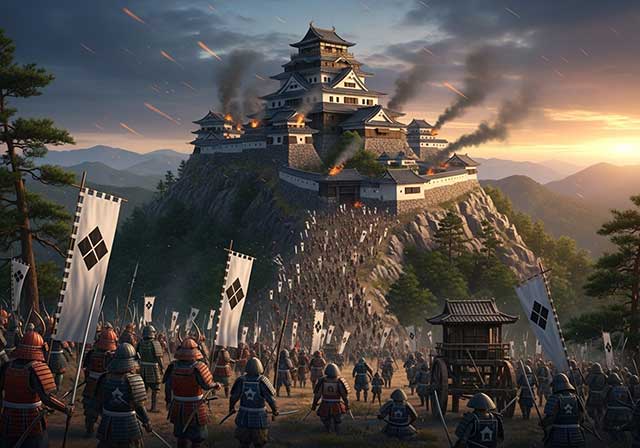
One of the important steps in the career of every Japanese commander was the uijin, the first military campaign in which he took part. For the legendary Takeda Shingen, according to some sources, this campaign was the siege of Unokuchi Castle.
Takeda Nobutora's Military Council
In 1536, Takeda Nobutora, father of Takeda Shingen, convened a military council to discuss plans for expansion. An agreement had recently been concluded with Imagawa Yoshimoto, which reliably protected the Takeda lands from possible invasion from the south. Thanks to this, Nobutora was able to turn his attention to the north. The council chose Unokuchi Castle in Shinano Province as the main target of the campaign.
Unokuchi Castle
The Chikuma River flowed through the Saku region of Shinano Province. Unokuchi Castle, also known as Torii, stood on a hilly ridge on its right bank.
The steep slopes of the hill provided reliable protection for the fortress. It is believed that the castle had three rings of fortifications, which made it quite large for its time. It housed an impressive garrison of about three thousand soldiers.
The commandant of the castle was Hiraga Genshin, the younger brother of Oi Sadataka, commandant of Nagakubo Castle. Genshin was a remarkable man: according to his contemporaries, he was two meters tall, and his long odachi sword commanded respect.
Storming such a fortification was no easy task for Takeda's army, as even poorly trained peasant infantrymen could defend themselves effectively by throwing stones at the attackers' heads.
The Takeda army's advance
Despite the difficulty of the task, Takeda's army of about 8,000 soldiers advanced into the Saku region in November 1536. After crossing the Shinshu Pass on the border with Shinano, the troops moved along the Tikum River and arrived in the Negoya area at the foot of the ridge.
The local population had already taken refuge in the mountains or joined the castle's defenders. This allowed Takeda's army to occupy the abandoned houses and use them as a camp.
After a short rest, attacks on the outer fortifications of the castle began. But the assault was extremely difficult: the slopes were steep, and winter brought deep snow (today, snow cover in this region can reach 60 cm). Attempts to take the fortress were unsuccessful.
Nobutora's retreat
By the end of December, Nobutora convened a new military council. The decision was made not to continue the siege: a long-term confrontation could bring victory, but it would be too costly. The soldiers were suffering from the winter conditions, and morale was falling. Nobutora led the main part of the army back to Kai Province.
Takeda Shingen's disobedience
However, the young Shingen had his own opinion about the campaign. As an inexperienced warrior, his father entrusted him with command of the rearguard to keep him out of danger.
But Shingen did not obey the order to retreat. Instead, he and 300 horsemen made their own attempt to storm the castle.
A surprise attack
The defenders of Unokuchi were celebrating the departure of Takeda's army. Confident that the threat had passed, they let their guard down. Shingen took advantage of this: his horsemen rushed towards the castle gates.
They encountered no serious resistance. Most of the defenders had already left the fortress. No more than eighty men remained in the castle to defend it.
Shingen's warriors quickly captured the castle. Hiraga Genshin fought bravely, wielding his odachi and inflicting heavy damage on his enemies. But the numerical superiority decided the outcome — he fell in battle and was beheaded. Shingen took his head with him as a trophy confirming his victory.
Meeting with his father
Nobutora settled with his army in Wakamiko Castle in the Koma region, where he awaited the return of the rearguard led by Shingen. He was greatly surprised when his son appeared before him with the head of Hiraga Genshin and reported on his own attack.
However, this news did not bring Nobutora any joy. A serious conflict arose between father and son. Nobutora was annoyed that Shingen had disobeyed his orders, and even more so that his 300 horsemen had succeeded where an army of 8,000 had failed. For Nobutora, this meant “losing face.”
Historical disagreements
There is debate among historians as to whether the siege of Unokuchi Castle actually took place. Some consider it a real event, while others suggest that the description was created by chroniclers to glorify Shingen.
This battle is mentioned in sources such as the Koyogunkan, Takeda Sandai Gunki, and Koetsu Gunki. However, there is no mention of it in the Myōhōji-ki and Kohakusai-ki chronicles, which describe the history of the Takeda clan in detail.
See also
-
The Siege of Hara Castle

The Shimabara Rebellion of 1637–1638, which culminated in the siege of Hara Castle, was the last major uprising of the Edo period and had serious political consequences.
-
Battle of Tennoji

The confrontation between Tokugawa Ieyasu and Toyotomi Hideyori during the “Osaka Winter Campaign” ended with the signing of a peace treaty. On January 22, 1615, the day after the treaty was signed, Ieyasu pretended to disband his army. In reality, this meant that the Shimazu forces withdrew to the nearest port. On the same day, almost the entire Tokugawa army began filling in the outer moat.
-
Siege of Shuri Castle

The Ryukyu Kingdom was established in 1429 on Okinawa, the largest island of the Ryukyu (Nansei) archipelago, as a result of the military unification of three rival kingdoms. In the following years, the state's control spread to all the islands of the archipelago.
-
The Siege of Fushimi Castle
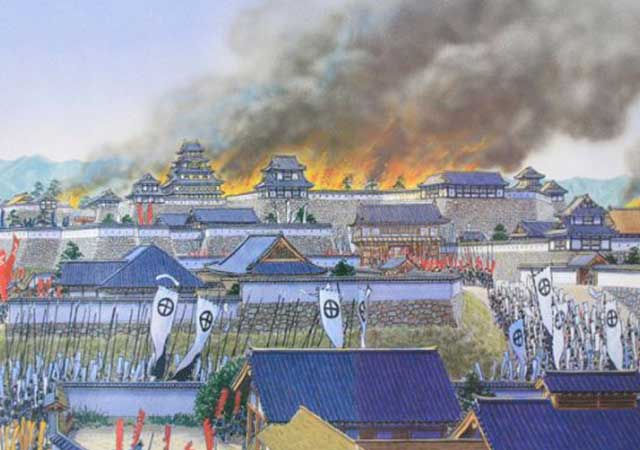
Fushimi can perhaps be considered one of the most “unfortunate” castles of the Sengoku Jidai period. The original castle was built by Toyotomi Hideyoshi in the southeast of Kyoto in 1594 as his residence in the imperial city.
-
The Siege of Otsu Castle
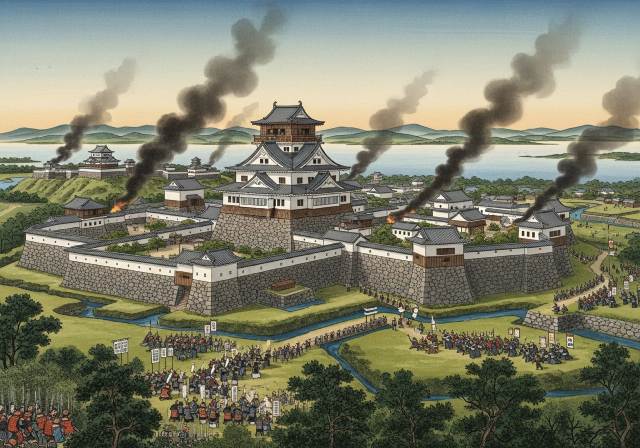
The siege of Otsu Castle was part of the Sekigahara campaign, during which the so-called Eastern Coalition, led by Tokugawa Ieyasu, fought against the Western Coalition, led by Ishida Mitsunari. Otsu Castle was built in 1586 by order of Toyotomi Hideyoshi near the capital Kyoto, on the site of the dismantled Sakamoto Castle. It belonged to the type of “water castles” — mizujō — as one side of it faced Japan's largest lake, Lake Biwa, and it was surrounded by a system of moats filled with lake water, which made the fortress resemble an island.
-
The Siege of Shiroishi Castle
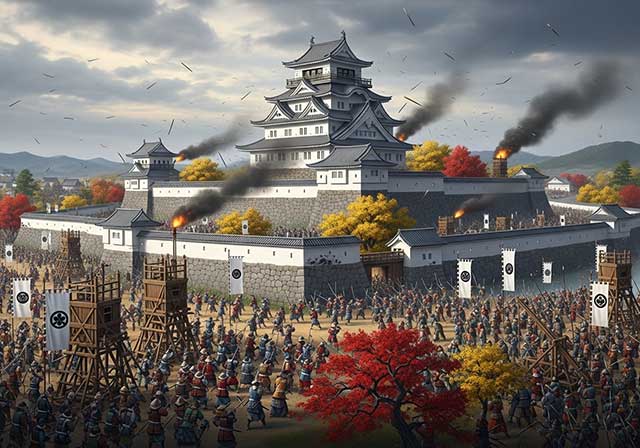
The siege of Shiroishi Castle was part of the Sekigahara campaign and took place several months before the decisive battle of Sekigahara. The daimyo of Aizu Province, Uesugi Kagekatsu, posed a serious threat to Tokugawa Ieyasu's plans to defeat the Western Coalition, and Ieyasu decided to curb his actions with the help of his northern vassals. To this end, he ordered Date Masamune to invade the province of Aizu and capture Shiroishi Castle.
-
The Second Siege of Jinju Castle
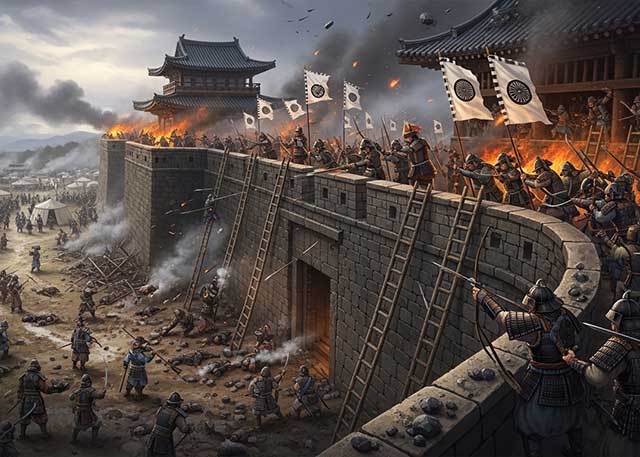
During the two Korean campaigns of the 16th century, the Japanese repeatedly had to capture enemy fortresses and defend occupied or constructed fortifications from the combined Korean and Chinese forces. Among all the operations of that time, the second siege of Jinju Castle is considered the most interesting from the point of view of siege warfare.
-
The Siege of Takamatsu Castle
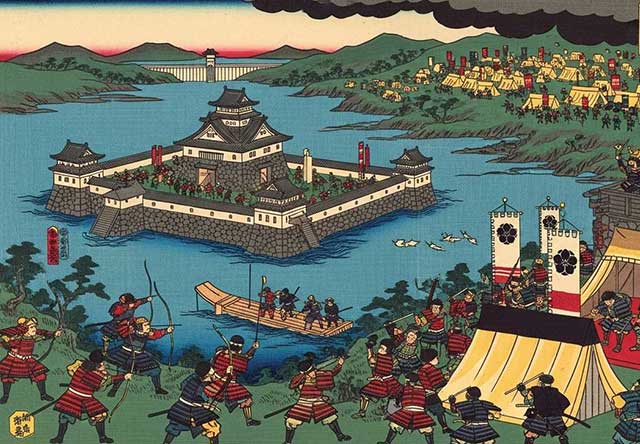
The siege of Takamatsu Castle in Bitchu Province is considered the first mizuzeme, or “water siege,” in Japanese history. Until then, such an original tactic had never been used.

